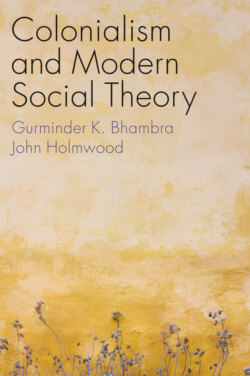Читать книгу Colonialism and Modern Social Theory - Gurminder K. Bhambra - Страница 12
Notes
Оглавление1 1 Quinn (1966) and Canny (2001) suggest that the model was first applied, albeit unsuccessfully, in Elizabethan England during its colonisation of Ireland before being applied with greater success in Virginia.
2 2 Settler colonialism is itself vulnerable to movements of independence against the authority of the metropole, to which the settlers see themselves as ‘equals’ (Veracini 2010). Thus Latin American independence movements that secured freedom from Spain and Portugal occurred in the early nineteenth century. Just as in the United States, they did not dispense with the institutions that typified colonialism, such as forced labour and the continued dispossession of indigenous peoples.
3 3 The ‘Hobbesian problem of order’ that Parsons (1937) discussed was not that of Hobbes’s texts; it was an analytical device meant to express the sociological problem of explaining the coordination of actions outside their framing in terms of utilitarian calculations of self-interest.
4 4 The book gave equal space to the Italian sociologist Vilfredo Pareto and to the English economist Alfred Marshall, but secondary engagements with Parsons’s argument are, for the most part, focused on his discussions of Weber and Durkheim and on his omission of Marx. As Marx comes into the canon, Pareto and Marshall recede.
5 5 The colleges that came to be known as ‘historically black colleges’ were, initially, integrated colleges – integrated by race and gender, albeit attracting few white students. By contrast, other universities serving white students operated segregation but have not been labelled ‘historically white’ (Smith 2016).
6 6 Giddens’s treatment of capitalism makes no room for a discussion of colonialism, enslavement, and dispossession, in contrast to the treatment of the writers he looks at. His only discussion of India, for example, is about its ‘traditionalism’ and how its system of religious belief, including the designations of caste, condemned it to economic backwardness after developments in the centuries before Christ that had produced an urban organisation similar to that of mediaeval Europe (Giddens 1971: 173). This type of formulation is a characteristic trope of Eurocentrism. Indian civilisation is recognised and identified as advanced and India is compared to Europe, but it is compared to mediaeval Europe, that is, to a Europe that has already transcended itself. Europe has the capacity for development, while India is represented as being in suspended animation.
